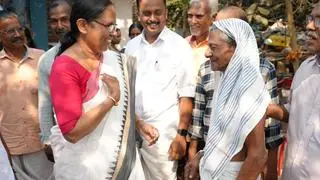Even as Chief Minister N Chandrababu Naidu was unveiling the master plan of Andhra Pradesh’s dream capital Amaravathi on Monday in Hyderabad, a human tragedy was unfolding in the 13 districts of his State. On that day, a staggering 100 people succumbed to the searing summer heat.
In neighbouring Telangana, where Chief Minister K Chandrasekhara Rao has been promising a ‘ Bangaru ’ (golden) State, the situation was only a shade better; the toll was not so overwhelming.
With the monsoon, predicted to hit the southern coastline on May 30, the entire peninsula is anxiously looking at the sky hoping for relief.
But, meanwhile, there is no respite from the Katri , which began on May 25 and is turning out to be a killer, with the toll in just the two States soaring past 1,000 (250 in Telangana) in the past week. Temperatures across the two States averaged 44 degrees C, and peaked to 48 degrees at places like Kothagudem in Telangana, and Gannavaram and East Godavari districts of AP as the Sun bore down relentlessly.
AP is no stranger to heat waves. Just last year, over 500 people died (170 of them in Hyderabad) when temperatures soared in May. In 2003, a particularly bad year, the toll was nearly 1,500. Summer temperatures soar cyclically. But the shocker this year is the spiralling rate of fatalities, which has caught the governments napping. Unlike other natural disasters like cyclones or floods, there seems to be no relief plan in place for heatwaves, rue experts.
The Met office has been forecasting heat wave conditions for the past two weeks. The spike of over three degrees in day temperatures since May 20 is attributed to a blast of hot, dry north-westerly winds. This unusually prolonged phase is one major cause for the surge in sunstroke deaths. While temperatures are 2-3 degrees above normal in most Telangana districts, they are up to 8 degrees higher in AP towns, says the Met Department in Hyderabad. Environmentalists blame the large-scale deforestation in the name of development for the rising temperatures and decreasing rains. The two States — AP and Telangana — had nothing concrete to offer the people reeling under the unprecedented heatwave beyond the routine advice — avoid exposure to the Sun between 11 a.m. and 4 p.m. and drink water.
Elsewhere, the heat wave killed 26 people in Odisha, with the mercury rising above 45 degrees Celsius in the past three days.
Ten people died in West Bengal as temperatures rose above 42 degrees Celsius. The day temperature in Allahabad hit 47.7 degrees Celsius on Sunday, according to the Met Department. New Delhi recorded a high of 44.5 degrees Celsius (112 degrees Fahrenheit) on Saturday. Authorities in New Delhi have not yet released any official death toll numbers from the heatwave. India Meteorological Department director BP Yadav warned the heat wave would continue in large parts of northern and southern India for a “few more days”.
Even the National Disaster Management Authority (NDMA), which lists hailstorms and cold waves as natural calamities, has not come around to granting that status to the lethal heatwave sweeping the country.
According to Marri Sashidhar Reddy, former Vice-Chairman of the NDMA, the intermittent rain during April and early May led to the government apparatus and the people lowering their guard and when the temperatures started to rise everyone was caught by surprise. He said several States have asked that heat wave be included in the list of natural calamities. The rains , predicted to hit the southern coastline on May 30, is expected to bring some relief but it will still be several weeks before the rains reach the dry northern parts.







Comments
Comments have to be in English, and in full sentences. They cannot be abusive or personal. Please abide by our community guidelines for posting your comments.
We have migrated to a new commenting platform. If you are already a registered user of TheHindu Businessline and logged in, you may continue to engage with our articles. If you do not have an account please register and login to post comments. Users can access their older comments by logging into their accounts on Vuukle.